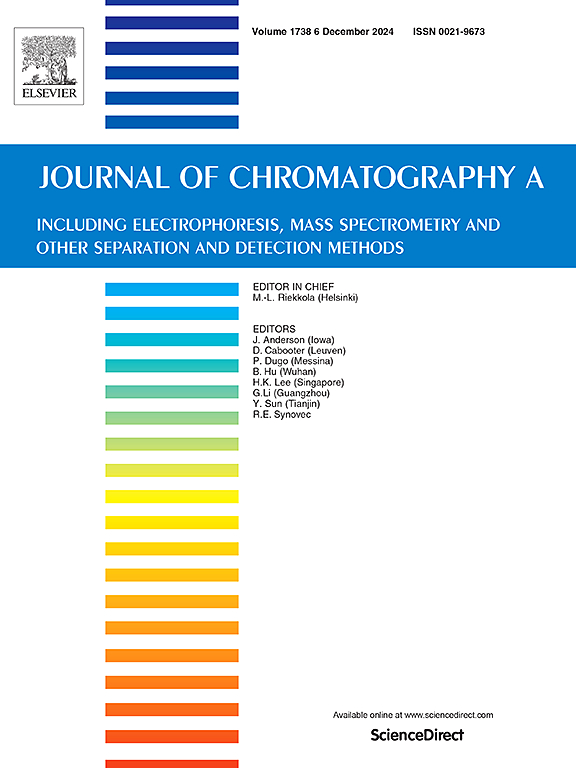具有 pH 依赖性表面电荷反转的宽孔全多孔辛基/吡啶基键合混合模式二氧化硅材料,可用于蛋白质的高性能疏水电荷诱导色谱。
IF 3.8
2区 化学
Q1 BIOCHEMICAL RESEARCH METHODS
引用次数: 0
摘要
为了克服蛋白质高效液相色谱中常用的反相丁基键合二氧化硅固定相上的亲硅相互作用,我们通过共同固定辛基和 2-吡啶基配体,制备了一种基于宽孔二氧化硅(3 µm,300 Å)的混合模式固定相。使用上述配体合成的功能性硅烷和预湿二氧化硅的新方法进行了表面改性。这种方法可以在二氧化硅表面生成一层致密的聚合硅氧烷层。为了进行比较,还制备了丁基键合二氧化硅和辛基/3-氨基丙基键合混合模式二氧化硅相。随后,通过元素分析了解配体密度,通过固态 29Si 和 13C 交叉极化/魔角旋转核磁共振光谱确认表面键合结构,以及通过电泳光散射测量随 pH 值变化的ζ电位,提供不同 pH 值下的净表面电荷信息,对改性二氧化硅进行了表征。经典的丁基键合固定相在整个研究的 pH 值范围(pH 值 3.5-9.5)内由于残留硅烷醇而显示负的ζ电位,而混合模式的辛基/3-氨基丙基键合二氧化硅在整个 pH 值范围内显示正的ζ电位,辛基/吡啶键合固定相在大约 pH 值 5.5 时观察到依赖于 pH 值的电荷反转。然后,通过乙腈梯度洗脱反相高效液相色谱法,对一组疏水性和等电点不同的蛋白质进行了测试,以评估三种合成固定相在 pH 值为 3-7.5 的范围内的保留特性。在酸性条件下(pH 值为 3),辛基/吡啶基-二氧化硅和辛基/氨基丙基-二氧化硅混合模式固定相由于排斥作用阻止了亲硅作用而降低了保留率并改善了峰形,同时通过其疏水性实现了蛋白质分离(排斥电荷辅助蛋白质 RPLC)。最后,在疏水电荷诱导色谱模式下,对制备的新型辛基/吡啶基键合混合模式固定相进行了评估,以分离相同测试集的蛋白质。在有机改性剂含量恒定为 10% 的情况下,洗脱不是通过有机改性剂梯度进行,而是通过 pH 值从接近中性到酸性的梯度进行。与上述有机梯度 RP-HPLC 相比,这种色谱模式显示出正交的保留特性和相反的洗脱顺序。此外,在这些条件下使用的有机溶剂也大大减少,因此被归类为绿色蛋白质液相色谱技术。本文章由计算机程序翻译,如有差异,请以英文原文为准。
Wide-pore fully porous mixed-mode octyl/pyridyl-bonded silica material with pH-dependent surface charge reversal for high-performance hydrophobic charge-induction chromatography of proteins
In an attempt to overcome silanophilic interactions like observed on popular reversed-phase butyl‑bonded silica stationary phases in protein HPLC, a mixed-mode stationary phase based on wide pore silica (3 µm, 300 Å) was prepared by co-immobilization of octyl and 2-pyridylethyl ligands. The surface modification was performed by a new approach using synthesized functional silatranes of the above ligands and prewetted silica. It allowed to generate a dense polymeric siloxane layer on the silica surface. Butyl-bonded silica and octyl/3-aminopropyl-bonded mixed-mode silica phases were prepared for comparison. The modified silicas were subsequently characterized by elemental analysis regarding ligand densities, by solid-state 29Si and 13C cross polarization/magic angle spinning nuclear magnetic resonance spectroscopy for confirming the surface-bonded structure, and by pH-dependent ζ-potential measurements via electrophoretic light scattering providing net surface charge information at distinct pH values. While the classical butyl‑bonded stationary phase revealed negative ζ-potential over the entire pH range investigated (pH 3.5–9.5) due to residual silanols and the mixed-mode octyl/3-aminopropyl-bonded silica positive ζ-potential over the entire pH range, pH-dependent charge reversal was observed at approximately pH 5.5 for the octyl/pyridyl-bonded stationary phase. Then, a test set of proteins differing in hydrophobicities and isoelectric points was employed to evaluate the retention characteristics of all three synthesized stationary phases over the pH range of 3 to 7.5 by acetonitrile-gradient elution reversed-phase HPLC. Under acidic conditions (pH 3) the mixed-mode phases octyl/pyridyl-silica and octyl/aminopropyl-silica showed reduced retention and improved peak shapes due to repulsive interactions preventing silanophilic interactions, while protein separations by their hydrophobicities were achieved (repulsive charge-assisted protein RPLC). Finally, the prepared novel mixed-mode octyl/pyridyl-bonded stationary phase was evaluated in hydrophobic charge induction chromatography mode for protein separation of the same test set. Instead of an organic modifier gradient, elution was enforced by a pH gradient from almost neutral to acidic pH at constant organic modifier content of 10 %. This chromatographic mode showed orthogonal retention characteristics and reversed elution order compared to above organic gradient RP-HPLC. In addition, significantly less organic solvent was used under these conditions, classifying it as a green protein LC technology.
求助全文
通过发布文献求助,成功后即可免费获取论文全文。
去求助
来源期刊

Journal of Chromatography A
化学-分析化学
CiteScore
7.90
自引率
14.60%
发文量
742
审稿时长
45 days
期刊介绍:
The Journal of Chromatography A provides a forum for the publication of original research and critical reviews on all aspects of fundamental and applied separation science. The scope of the journal includes chromatography and related techniques, electromigration techniques (e.g. electrophoresis, electrochromatography), hyphenated and other multi-dimensional techniques, sample preparation, and detection methods such as mass spectrometry. Contributions consist mainly of research papers dealing with the theory of separation methods, instrumental developments and analytical and preparative applications of general interest.
 求助内容:
求助内容: 应助结果提醒方式:
应助结果提醒方式:


